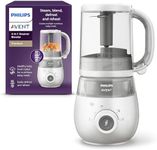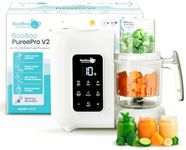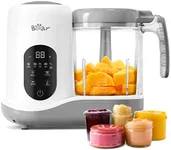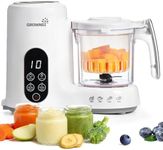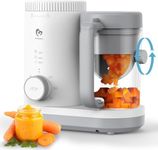Buying Guide for the Best Baby Food Makers
Choosing the right baby food maker can make a significant difference in the ease and quality of preparing nutritious meals for your little one. When selecting a baby food maker, it's important to consider various features and specifications to ensure it meets your needs and preferences. Here are some key specs to look out for and how to navigate them.FunctionalityFunctionality refers to the different tasks the baby food maker can perform, such as steaming, blending, reheating, and defrosting. This spec is important because a multifunctional device can save you time and effort. Some baby food makers only blend, while others can steam and blend in one unit. If you want an all-in-one solution, look for a model that offers multiple functions. If you already have a steamer or blender, a simpler model might suffice.
CapacityCapacity indicates how much food the baby food maker can prepare at one time. This is important because it affects how often you'll need to use the device. Small capacity models (1-2 cups) are suitable for making fresh meals daily, while larger capacity models (3-4 cups or more) are better for batch cooking and storing food for later use. Consider your cooking habits and how much food you want to prepare in one go to choose the right capacity for you.
Ease of CleaningEase of cleaning refers to how simple it is to clean the baby food maker after use. This is crucial because baby food makers can get messy, and you want to ensure that cleaning is quick and hassle-free. Models with dishwasher-safe parts or those that can be easily disassembled for hand washing are ideal. If you prefer minimal cleaning effort, look for a model with fewer parts and smooth surfaces that are easy to wipe down.
MaterialThe material of the baby food maker, especially the parts that come into contact with food, is important for safety and durability. Look for BPA-free, phthalate-free, and lead-free materials to ensure the food remains safe for your baby. Stainless steel and high-quality plastic are common materials. If you prioritize safety and longevity, opt for models made from high-quality, non-toxic materials.
Size and StorageSize and storage refer to the physical dimensions of the baby food maker and how easy it is to store when not in use. This is important if you have limited counter or storage space. Compact models are ideal for small kitchens, while larger models may offer more features but require more space. Consider the available space in your kitchen and how often you plan to use the device to determine the best size for you.
Ease of UseEase of use encompasses how user-friendly the baby food maker is, including the simplicity of its controls and the clarity of its instructions. This is important because you want a device that makes meal preparation straightforward and stress-free. Look for models with intuitive controls, clear labeling, and straightforward assembly. If you're new to using kitchen appliances, a model with simple, one-touch operations might be the best choice.
SpeedSpeed refers to how quickly the baby food maker can prepare food. This is important for busy parents who need to prepare meals quickly. Some models can steam and blend food in under 20 minutes, while others may take longer. If you need to prepare meals in a hurry, look for a model known for its fast operation. If speed is less of a concern, you might prioritize other features over this spec.

